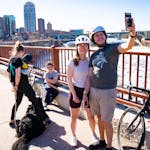Crime has dropped by double-digit percentages across Minneapolis compared to last year, a trend that observers are chalking up to improved crime-fighting techniques and better cooperation from residents in some of the toughest neighborhoods.
Downtown's First Precinct and south Minneapolis' Third Precinct have seen the largest improvements. Reported crime in the ethnically diverse Third, the city's largest precinct by area, receded about 19 percent, compared with the same time period in 2017 — driven largely by big drops in robberies and burglaries — according to crime statistics released last week. The First, which covers downtown and the Cedar-Riverside neighborhood, has also seen a 17 percent drop in serious crimes like robbery, burglary and assault.
Minneapolis Police Chief Medaria Arradondo, speaking at a private event for business executives this month, said that unchecked crime downtown undermines Minneapolis' image as a safe place for visitors and residents alike.
"People will gauge their city's level of hope through their downtown," he said, while pointing to double-digit percentage declines in property and violent crime. "Now, while those are numbers, those are also human beings' lives — those are hundreds of less people that have been robbed, that have been assaulted."
At a community meeting last month, Third Precinct inspector Michael Sullivan called the area's violent crime drop one of the largest he could recall in his career, but acknowledged that stretches of East Lake Street and East Franklin Avenue "are still dealing with significant street level crimes and that remains a focus."
Authorities say that most of the violence in the Third is related to street gangs and drugs in an area that has been at the center of Minneapolis' opioid crisis.
Like other departments across the country, Minneapolis police are increasingly using predictive software to forecast where and when crime will occur. The programs use sophisticated computer algorithms to identify environmental factors that attract crime — for example, parking lots near bustling retail areas, which create "target rich" areas for would-be pickpockets and robbers.
The efforts are paying dividends, authorities say. Robberies, considered an indicator of a city's overall safety, they are down by roughly a third citywide.
This, after Third Precinct officers in recent years started noticing a surge in street stickups of Latino immigrants, who often carry large amounts of cash instead of depositing it and are wary of reporting crimes out of fear of being reported to immigration officials. The trend has eased recently, as police stepped up outreach efforts and worked with Spanish-language media to heighten awareness about the robberies.
Across Minneapolis, violent crime was down about 19 percent year-over-year, while property crime fell nearly 13 percent in that span.
Recent statistics show that burglaries have also gone down in four of the five police precincts, with the exception of northeast Minneapolis, where the numbers remained steady. The Northeast Second Precinct was also the only one to see an increase in violent crime, fueled mostly by a jump in aggravated assaults like shootings and stabbings.
Before last year, the citywide violent crime rate — the number of crimes per population — had been trending upward after plummeting during the late 2000s, according to a Star Tribune analysis of available data. This mirrored a national trend, with recently released FBI statistics showing a slight dip in the country's violent crime rate in 2017 after years of increases.
At the same time, police are locking fewer people up, with total arrests falling about 22 percent across the city, compared with 2017. In the Third Precinct, they declined by 30 percent.
Over the years, criminologists have debated many possible theories for why crime has generally fallen over the past three decades. Among them: the declining popularity of crack cocaine that fueled the homicide surge of the late 1980s and early 1990s, evidence-based strategies that focus on the most dangerous people and places, and the development of proven alternatives to incarceration to help those struggling with drugs or mental illness deal with their problems and avoid future criminality.
But, says University of Minnesota sociology Prof. Michelle Phelps, the lack of scholarly consensus about crime's root causes makes yearly statistical comparisons tricky.
"We often think when crime goes up or down, sort of the first finger to blame or praise is the police; and sometimes that's true," she said. "But we should also ask what's happened with community structures, what's happened with community violence programs, what's happened with social services, what's happening with health care?"
Longtime community organizer Abdirizak Bihi said that despite a flare-up in violence between St. Paul and Minneapolis Somali gangs, public safety has improved in the Seward and Cedar-Riverside neighborhoods as police have worked to close the gap of distrust with the East African community, leading to more witnesses coming forward with information. "When people come to safety meetings and complain about crimes, then law enforcement listen," he said.
While Carol Pass said she sympathizes with the homeless people living in the homeless encampment off Hiawatha Avenue, she also thinks the encampment has led to more business burglaries, with thieves stealing propane tanks, flashlights, batteries and other survival items as winter approaches.
"Anything that could help you with living outdoors, they cut the boxes open and put them back on the shelf" empty, said Pass, president of the East Phillips Improvement Coalition and a former college professor.
Caitlin Cook-Isaacson, of the Central Area Neighborhood Development Organization, said that groups like hers are starting to take a more holistic approach to crime prevention.
Crime "exposes where there's a need, where there's a gap in services, something that society should be paying attention to, and not just to lock somebody up, necessarily," she said.
Libor Jany • 612-673-4064 Twitter: @StribJany





